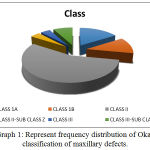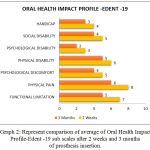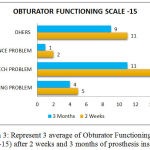Parithimar kalaignan and Jaya Shree Mohan
and Jaya Shree Mohan
Department of Prosthodontics, Vinayaka missions Sankarachariyar dental college, Salem.
Corresponding Author E-mail: parithisiva@gmail.com
DOI : https://dx.doi.org/10.13005/bpj/1428
Abstract
Maxillofacial defects cause impact on oral health related quality of life (OHRQol) including limitations in functional activities, communication, social interaction, and intimacy. The obturator prosthesis is commonly used as an effective means for rehabilitating maxillectomy patients. The purpose of this study was to investigate impact of definitive obturator prosthesis on oral health related quality of life. In the period between 2015 -2017, a total of twenty five (25) patients with acquired maxillary defects based on Okay classification have been selected and rehabilitated with definitive obturator prostheses .The OHRQol was measured using the Oral Health Impact Profile (OHIP-Edent-19) and Obturator functioning scale (OFS) with standardized questionnaire after 2 weeks & 3months of prosthesis function.To find the significant difference between the bivariate samples in Paired groups the Wilcoxon signed rank test was used. With respect to oral health impact profile –Edent 19 scale, the mean functional limitation score were 6.72 and 5.20 indicates that there is significant improvement in chewing performance after 2 weeks and 3 months of prosthesis function. Significant improvement in oral health impact profile was noticed in physical (M = 5.84, 4.88), Psychological (M=4.84, 3.96) and social disabilities (M=5.28, 4.16). Similarly, when observed with Obturator functioning scale, significant improvement were noted in chewing performance phonetics, appearance and miscellaneous aspects. Analysing the OHIP –Edent-19 scale and obturator functioning scale (OFS-15), statistically significant differences (Wilcoxon rank test p value = 0.0005) were observed. Within the limits of this study, it can be concluded that highly positive correlation exists between definitive obturator prostheses and oral health related quality of life (OHRQol).
Keywords
definitive obturator prosthesis functioning scale; oralo bturator health impact profile;
Download this article as:| Copy the following to cite this article: kalaignan P, Mohan J. S. Impact of Maxillofacial Prostheses on Oral Health Related Quality of Life (OHRQoL). Biomed Pharmacol J 2018;11(2). |
| Copy the following to cite this URL: kalaignan P, Mohan J. S. Impact of Maxillofacial Prostheses on Oral Health Related Quality of Life (OHRQoL). Biomed Pharmacol J 2018;11(2). Available from: http://biomedpharmajournal.org/?p=20282 |
Introduction
Maxillofacial defect can result in, functional, cosmetic and Psychological impairment greatly affecting the patient’s quality of life.1Maxillary defect can be rehabilitated with either tissue grafting or using obturator prosthesis.2
Although, surgical reconstructions,3 have some advantages but it is not always possible because of the condition of the patient. So, prosthetic rehabilitation may be one of the possible solutions.4,5
Prosthetic intervention,6 with a maxillary obturator prosthesis, is necessary to restore form and contours of the defect and to recreate the functional separation of the oral and nasal cavity.
In 2001, Okay and colleagues,7 proposed a maxillectomy defect classification system with a view toward the assessment of functional outcome, prosthetic retention, and patient satisfaction. Based on a retrospective review of47 consecutive maxillectomy defects, this classification scheme also was the first to take the status of the zygomatic arch and orbital floor into direct consideration. They classified palato-maxillary defects into 3 major classes and 2 sub-classes.
A variety of instruments have been developed to measure Oral health related quality of life (OHRQoL).8,9 The oral health impact profile10,11 (OHIP) is a self-administered instrument specifically designed to measure the impact of oral health on psychological wellbeing and quality of life .This questionnaire includes 49 items that includes seven domains; functional limitation ,physical pain ,psychological discomfort, physical disability ,psychological disability ,social disability and handicap.12,13
Accordingly, a new subscales of 19-OHIP statements specifically for edentulous patients was developed – the Oral Health Impact Profile for Edentulous subjects,14 (OHIP-EDENT) (Allen and Locker, 2002). The item impact method is used to select items that are most relevant to edentulous patients. The five categories of responses are 1) never, 2) hardly ever, 3) occasionally, 4) fairly often and 5) very often. They are scored from 0 for never 1 to 5 for very often, with lower scores representing a better OHRQol. This instrument has been tested for reliability and validity.
Oral health related Quality of life has become the focus of attention during recent years in maxillofacial rehabilitation; patient’s psychological wellbeing and the patients’ vitality are increasingly contributing to the evaluation of therapeutical success.
Keeping the above factors in mind the present study was carried out to compare and evaluate the impact of Definitive Obturator prosthesis on oral health related quality of life in maxillary defects by oral health impact profile (OHIP-Edent) and obturator functioning scale (OFS).
Material and Methods
Study Design
This descriptive cross sectional study was conducted at Vinayaga mission’s dental college, Salem in the period between 2015 to 2017. A total of twenty five (25) patients with acquired maxillary defects based on Okay classification have been selected for this study (Table 1 & Bar Chart 1).
Table 1: represent frequency distribution of Okay classification for maxillary defects.
| Frequency distribution | |||
| Okay Classification | |||
| Frequency | Percent | ||
| Valid | CLASS 1A | 4 | 16.0 |
| CLASS 1B | 3 | 12.0 | |
| CLASS II | 14 | 56.0 | |
| CLASS II-SUB CLASS Z | 1 | 4.0 | |
| CLASS III | 1 | 4.0 | |
| CLASS III-SUB CLASS Z | 2 | 8.0 | |
| Total | 25 | 100.0 | |
 |
Graph 1: represent frequency distribution of Okay classification of maxillary defects.
|
The patients were provided written informed consent prior to their participation after obtaining ethical clearance. Definitive Obturator prostheses were carried out for acquired maxillary defects. OHRQoL was measured using the Oral Health Impact Profile –Edent (OHIP-Edent-19), and Obturator functioning scale (OFS) with standardized questionnaire after 2 weeks & 3 months of Obturator prosthesis insertion.
The OHIP-EDENT consists of 19 statements derived from the OHIP using an item impact method. Oral Health Impact Profile (OHIP-EDENT) which includes seven domains /items Functional limitation, Physical pain, Psychological discomfort, Physical disability Psychological disability, social disability &Handicap (Table 2).
Table 2: represent mean, standard deviation of Oral Health Impact Profile-Edent -19 (OHIP-EDENT) sub scales after 2 weeks and 3 months of prosthesis insertion.
| Paired Samples Statistics | |||||
| Mean | N | Std. Deviation | Std. Error Mean | ||
| Pair 1 | FUNCTIONAL LIMITATION 2W | 6.72 | 25 | 1.745 | .349 |
| FUNCTIONAL LIMITATION 3M | 5.20 | 25 | 1.354 | .271 | |
| Pair 2 | PHYSICAL PAIN 2W | 8.24 | 25 | 2.026 | .405 |
| PHYSICAL PAIN 3M | 5.84 | 25 | 1.375 | .275 | |
| Pair 3 | PSYCHOLOGICAL DISCOMFORT 2W | 4.84 | 25 | 1.068 | .214 |
| PSYCHOLOGICAL DISCOMFORT 3M | 3.96 | 25 | .735 | .147 | |
| Pair 4 | PHYSICAL DISABILITY 2W | 5.84 | 25 | 1.106 | .221 |
| PHYSICAL DISABILITY 3M | 4.88 | 25 | .781 | .156 | |
| Pair 5 | PSYCHOLOGICAL DISABILITY 2W | 3.32 | 25 | .900 | .180 |
| PSYCHOLOGICAL DISABILITY 3M | 2.48 | 25 | .823 | .165 | |
| Pair 6 | SOCIAL DISABILITY 2W | 5.28 | 25 | 1.429 | .286 |
| SOCIAL DISABILITY 3M | 4.16 | 25 | 1.313 | .263 | |
| Pair 7 | HANDICAP 2W | 3.60 | 25 | .577 | .115 |
| HANDICAP 3M | 3.04 | 25 | .735 | .147 | |
| Pair 8 | OHIP 2W | 5.4057 | 25 | 1.00820 | .20164 |
| OHIP 3M | 4.2229 | 25 | .83001 | .16600 | |
A 15 item obturator functioning scale (OFS) designed by kornblith et al to assess the masticatory ability, speech, communication difficulties and cosmetic satisfaction (Table 3).
Table 3: Represent shown of mean, standard deviation of obturator functioning scale (OFS-15) after 2 weeks and 3 months of prosthesis insertion.
| Paired Samples Statistics | |||||
| Mean | N | Std. Deviation | Std. Error Mean | ||
| Pair 1 | CHEWING PROBLEM 2W | 4.84 | 25 | 1.434 | .287 |
| CHEWING PROBLEM 3M | 3.60 | 25 | .707 | .141 | |
| Pair 2 | SPEECH PROBLEM 2W | 14.04 | 25 | 2.282 | .456 |
| SPEECH PROBLEM 3M | 10.88 | 25 | 1.563 | .313 | |
| Pair 3 | APPEARANCE PROBLEM 2W | 1.88 | 25 | .666 | .133 |
| APPEARANCE PROBLEM 3M | 1.16 | 25 | .374 | .075 | |
| Pair 4 | OHERS 2W | 10.76 | 25 | 2.697 | .539 |
| OHERS 3M | 8.80 | 25 | 1.826 | .365 | |
| Pair 5 | OFS 2W | 7.8800 | 25 | 1.53623 | .30725 |
| OFS 3M | 6.1100 | 25 | .94119 | .18824 | |
Patients were asked serious of questions. All the answers to the questions were coded and entered into a excel sheet by a single operator.
Statistical Analysis
The collected data were analysed with IBM.SPSS statistics software 23.0 Version.
To describe about the data descriptive statistics frequency analysis, percentage analysis were used for categorical variables and the mean & S.D were used for continuous variables. To find the significant difference between the bivariate samples in Paired groups the Wilcoxon signed rank test was used. In the above statistical tool the probability value .05 is considered as significant level.
Results
With respect to oral health impact profile –Edent 19 scale, the mean functional limitation score were 6.72 and 5.20 indicates that there is significant improvement in chewing performance after 2 weeks and 3 months of prosthesis function respectively (Table 4).
Table 4: represent level of significance of Oral Health Impact Profile-Edent -19 (OHIP-EDENT sub scales after 2 weeks and 3 months of prosthesis insertion.
| Z | Asymp. Sig. (2-tailed) | |
| FUNCTIONAL LIMITATION 3M – FUNCTIONAL LIMITATION 2W | -3.998b | 0.0005 |
| PHYSICAL PAIN 3M – PHYSICAL PAIN 2W | -4.320b | 0.0005 |
| PSYCHOLOGICAL DISCOMFORT 3M – PSYCHOLOGICAL DISCOMFORT 2W | -4.119b | 0.0005 |
| PHYSICAL DISABILITY 3M – PHYSICAL DISABILITY 2W | -4.062b | 0.0005 |
| PSYCHOLOGICAL DISABILITY 3M – PSYCHOLOGICAL DISABILITY 2W | -3.217b | 0.001 |
| SOCIAL DISABILITY 3M – SOCIAL DISABILITY 2W | -3.785b | 0.0005 |
| HANDICAP 3M – HANDICAP 2W | -2.889b | 0.004 |
| OHIP 3M – OHIP 2W | -4.380b | 0.0005 |
a. Wilcoxon Signed Ranks Test
b. Based on positive ranks.
Even though improvement in denture comfort (Mean =8.24) was observed in 2 weeks of prosthesis function, there is progressive (Mean=5.84) and much improved outcome related to physical pain over physical pain in 3 months of prosthesis function.
Significant improvement in oral health impact profile was noticed in physical (M = 5.84, 4.88), Psychological (M=4.84, 3.96) and social disabilities (M=5.28, 4.16) (table 5)
When observed with obturator functioning scale, the mean of 4.84 and 3.60 for chewing performance indicates that they were hardly ever problems with leakage of foods during chewing (Table 5).
Table 5: represent level of significance of obturator functioning scale (OFS) after 2 weeks and 3 months of prosthesis insertion.
| Z | Asymp. Sig. (2-tailed) | |
| CHEWING PROBLEM 3M – CHEWING PROBLEM 2W | -3.703b | .0005 |
| SPEECH PROBLEM 3M – SPEECH PROBLEM 2W | -4.302b | .0005 |
| APPEARANCE PROBLEM 3M – APPEARANCE PROBLEM 2W | -3.626b | .0005 |
| OHERS 3M – OHERS 2W | -4.012b | .0005 |
| OFS 3M – OFS 2W | -4.378b | .0005 |
Likewise, there is significant improvement in obturator functioning scale was noticed in phonetics, appearance and miscellaneous aspects.
Since rehabilitation with definitive obturator prostheses showed marked positive subjective responses to the each subscale.
When analysing the OHIP –Edent-19 scale and obturator functioning scale (OFS-15), statistically significant differences (Wilcoxon rank test p value = 0.0005) were observed (Table 6)
Rehabilitation of maxillofacial defects with definitive obturator had an enormous positive impact of oral health related quality of life (OHRQol) in terms of functional, physical, psychological and social aspects.
Discussion
In modern years, there has been growing interest in using patient-reported psychosocial problems, and to observe a patient’s progress over a period of time.
Maxillo -Facial defects as a result of a congenital or acquired origin can have overwhelming effects on the functional, economic, esthetic and psychosocial aspects of a person’s life.
Maxillofacial prosthetics, as an alternative to surgery, offer prosthodontic rehabilitation, seeking to provide satisfactory function ,aesthetics and quality of life (QOL), and thus to facilitate restoration of patients in in their family situations and social environments.15
Earlier studies have shown that patients with acquired maxillofacial defects had greater physical, psychological and social impairment of QOL than patients with congenital defects.16,17 Because of this, in a clinical setting, the identification of the need for prosthetic rehabilitation in these patients, a process which can restore QOL, is most important. The evaluation of patients oral health related QOL related to prosthetic rehabilitation may provide valuable information to assist the maxillofacial prosthodontic team in treatment planning, monitoring, and outcome assessment.18
Maxillectomy patients with definitive obturator rehabilitation; their mean score of functional limitation in this study 7 and 5 were observed in the oral health impact profile Edent scale(chart 2).
 |
Graph 2: Represent comparison of average of Oral Health Impact Profile-Edent -19 sub scales after 2 weeks and 3 months of prosthesis insertion.
|
Similarly, observed mean score of chewing performance in obturator functioning scale were 5 and 4 (chart 3). This lower scores indicates that maxillary definitive obturator definitely enhance the oral health related quality of life.
 |
Graph 3: Represent 3 average of Obturator Functioning Scale (OFS-15) after 2 weeks and 3 months of prosthesis insertion.
|
Statistically Significant differences (p <.0005) were observed after 2 weeks and 3 months of prosthesis function in both oral health impact profile –Edent and obturator functioning scale.
In this study, we also found that there is significant positive impact of obturator prosthesis in oral health quality of life in terms of functional, physical, psychological, social and esthetics well-being of the patients.
Conclusion
The primary objective of rehabilitation is to preserve and restore the functional activities and enhancement of self-confidence of the patients so they can return to society; who have affected with consequences of maxillofacial defect.
Within the limits of this study, it can be concluded that highly positive correlation exists between definitive obturator prostheses and oral health related quality of life (OHRQol)
By providing a comprehensive assessment of oral health related quality of life, the oral health impact profile –Edent and obturator functioning scale offers a broader perspective on maxillofacial defects and their rehabilitation.
Thus, the information has the potential to help determine treatment essentials, select appropriate rehabilitation, monitor treatment progress, and assess the outcome for these maxillofacial in context of research and clinical Practice.
References
- Cordeiro P.G, Santamaria E. A. classification system and algorithm for reconstruction of maxillectomy and midfacial defects. Plastic Reconstr Surg.2000;105:2331-2346.
CrossRef - Beumer J, Curtis T.A, Marunick M.T.editors Maxillofacial rehabilitation: prosthodontic and surgical considerations. Tokyo Ishiyaku Euro America Inc.1996.
- Rahn A.O, Goldman B.G, Parr G.R. Prosthodontic principles in the surgical planning for maxillary and mandibular resection patients. J. Prosthet Dent.1979;42:429-33.
CrossRef - Fearraigh, P.O.Review of Methods used in the reconstruction and rehabilitation of the maxillofacial region. J. of the Irish Dental Association.2009;56(1):32-37.
- Desjardins R.P. Obturator prosthesis design for acquired maxillary defects. J. Prosthet Dent.1978;39:424-32.
CrossRef - Keyf, F. Obturator prosthesis for hemimaxillectomy patients. J.Oral Rehab.2001;28:821-29.
CrossRef - Okay D.J, Genden E, Buchbinder D, Urken M. Prosthetic Guidelines for surgical reconstruction of the maxilla a classification system of defects. J. Prosthet Dent.2001;86:352-63.
CrossRef - Locker D. Concepts of oral health, disease and the quality of life. In Measuring oral health and quality of life Edited by Slade GD. Chapel Hill. University of North Carolina. Dental Ecolog. 11-24.
- Allen P.F, McMillan A.S and Locker D. An assessment of the responsiveness of the Oral Health Impact Profile in a clinical trial. Comm Dent Oral Epidemiol.2001;29:175-182.
CrossRef - Locker D and Slade G.D.Association between clinical and subjective indicators of oral health status in an older adult population. Gerodontology.1994;11:108-114.
CrossRef - Locker D, Matear D, Stephens M, Lawrence H, Payne B. Comparison of the GOHAI and OHIP-14 as measures of the oral health-related quality of life of the elderly. Community Dent Oral Epidemiol.2001;29(3):73–81.
- Locker D . Measuring oral health A conceptual framework. Community Dental Health.1988;5:3-18.
- Kornblith A.B, Zlotolow I.M, Gooen J, Huryn J.M, Lerner T, Strong E.W, Shah J.P, Spiro R.H, Holland J.C. Quality of life of maxillectomy patients using an obturator prosthesis. Head Neck.1996;18:323-34.
CrossRef - Allen P.F and Locker D. A. modified short version of the Oral Health Impact Profile for assessing health related quality of life in edentulous adults. Int. J. Prostho.2002;15:446-450
- Carr A.B. Cosmetic and functional prosthetic rehabilitation of acquired defects. In Otolaryngology Head and Neck surgery, 3rdedition, Cummings, C.W, Fredrickson, J.M, Harker, L.A. et al Eds, Mosby Publication.1998;1612-1634.
- Rieger J.M, Wolfaardt J.F, Jha N, Seikaly H. Maxillary obturators: the relationship between patient satisfaction and speech outcome. Head Neck.2003;25(1):895-903.
CrossRef - Slade G.D and Spencer A.J. Development and evaluation of the Oral Health Impact Profile. Community Dent Health.1994;11:3-11.
- Michaud P.L, de Grandmont P, Feine J.S, Emami E. Measuring patient-based outcomes: Is treatment satisfaction associated with oral health-related quality of life. J. Dent. 2012;40:624.
CrossRef








